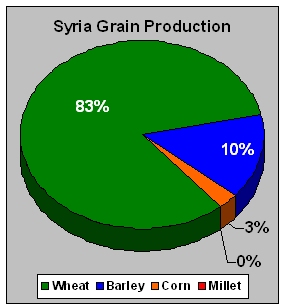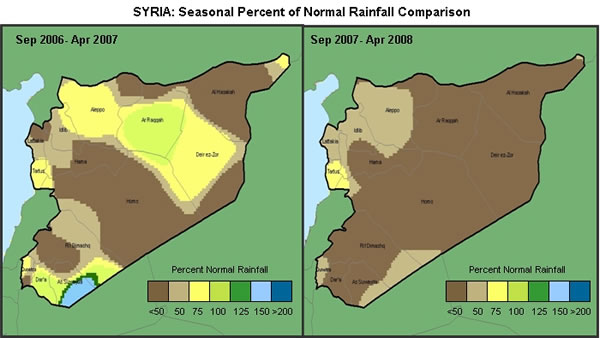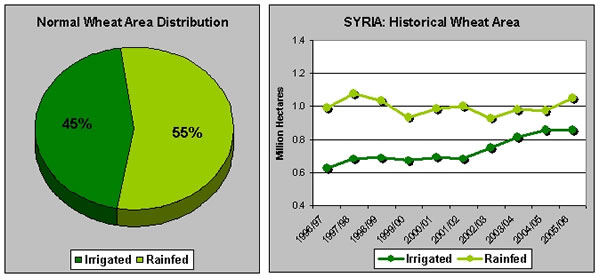SYRIA: Wheat Production in 2008/09 Declines Owing to Season-Long Drought
 Syria, like its neighbor Iraq, has been experiencing a serious drought during the past 8 months. Drought stress in 2008/09, which was exacerbated by abnormally hot spring temperatures, is expected to cause significant losses to the nation’s winter grain crops. Wheat production is expected to decline 38 percent compared to last year, to the lowest level in the past seventeen years. As the chart at the right illustrates, wheat is the single most important food grain grown in Syria, and this year’s projected shortfall could lead to a significant drawdown in domestic stocks unless the country increases imports or the government raises procurement prices high enough to capture a larger proportion of the domestic crop this year. Syria, like its neighbor Iraq, has been experiencing a serious drought during the past 8 months. Drought stress in 2008/09, which was exacerbated by abnormally hot spring temperatures, is expected to cause significant losses to the nation’s winter grain crops. Wheat production is expected to decline 38 percent compared to last year, to the lowest level in the past seventeen years. As the chart at the right illustrates, wheat is the single most important food grain grown in Syria, and this year’s projected shortfall could lead to a significant drawdown in domestic stocks unless the country increases imports or the government raises procurement prices high enough to capture a larger proportion of the domestic crop this year.
Extremely low rainfall conditions have affected much of Syria during the 2008/09 winter grain growing period, with drought conditions increasing in severity as the season progressed. Total rainfall accumulations averaged between 15-30 percent of normal for most of the primary wheat producing areas, with the exception of western coastal regions (minor producing areas) which received more beneficial winter rains. This amounts to an average of about 2 inches or less total rainfall during the 8 months between September 2007 and April 2008 in the major wheat producing governorates (provinces).

As in Iraq, there was little to no measurable rainfall this year in the planting period from October-December in the primary wheat producing regions of northeastern Syria (see charts below). The governorates of Al Hasakah, Ar Raqqah, and Aleppo, which together account for 73 percent of total national wheat area and 65 percent of total production, were particularly affected by extremely low rainfall and poor planting conditions. These regions are illustrated by the second and third rainfall accumulation charts below. The first chart illustrates the much more beneficial rainfall conditions in western areas nearer the Mediterranean coast. Moisture conditions were so poor at the start of the season that large swaths of rainfed grains across northeastern Syria apparently went unplanted or never germinated. In addition to severe dryness, daytime temperatures in March and April have been well-above normal in much of the country, adding additional stress to established irrigated and non-irrigated grain crops. These abnormally high temperatures will likely take a toll on the 2008/09 crop, by reducing the yield potential of the crop in areas where adequate water was not available. Wheat harvest activities typically occur in June and early July, so crops have generally been in reproductive growth stages while these adverse temperatures predominated.

Moderate resolution satellite imagery from the NASA MODIS satellite has been used this winter to evaluate winter grain growing conditions in Syria. From early January 2008 it became apparent that a significant drought situation was unfolding, as normally vibrant crop emergence in key northern major producing regions (Al Hasakah, Ar Raqqah, and Aleppo governorates) was absent. Late in the growing season, vegetative index maps illustrating the geographical difference in vegetation abundance and vigor (see maps below) shows a marked decline in total area vegetated in 2008 when compared to last year. This implies that a major portion of the country’s non-irrigated wheat crop will not be harvested this year in the drought-affected regions, and that which does survive will have extremely poor yields. It also suggests that some irrigated acreage also did not get completely established, and may not be harvested this year. Fortunately, beneficial rainfall did support a relatively healthy winter grain crop in the southwestern governorates closest to the Mediterranean Sea, though these areas typically account for only 25 percent of the nation’s wheat output.

Wheat production prospects in the 2008/09 growing season are expected to be the worst since droughts in 1989-1991, when total production fell as much as fifty percent to between 1.0-2.1 million tons. As illustrated in the regional wheat production map below, at least 75 percent of the country’s wheat production is focused in the northeastern areas which are severely affected by deficient moisture and are showing extremely reduced vegetation in the satellite image analysis. These areas make up the “breadbasket” of the country, with losses there expected to have serious ramifications in the domestic food and feed grain market in the 2008/09 marketing year.

Owing to prolonged drought conditions wheat production in 2008/09 is forecast by USDA at 2.5 million tons, down 1.5 million or 38 percent from last year. Given the forecast for a significant shortfall in production this year, the government may need to act in a variety of ways to secure more wheat. It can increase procurement of the domestic crop, increase imports, and/or allow a higher-than-normal drawdown of national reserve stocks. FAS Damascus reports the government has recently increased domestic grain procurement prices in response to the drought, with hard wheat set at $359 per metric ton, soft wheat at $348 per MT, and barley $326 per MT. Despite these increases, government rates are still estimated to be approximately 47 percent below current domestic market rates in Syria. Therefore, farmers are very unlikely to sell their grain crops to the government this year. The Syrian government is faced with a quandary, as it has a traditional preference to maintain a buffer stock of at least a year’s milling wheat requirements for the country, which is currently in excess of 4.0 million tons. FAS Damascus reports, however, that owing to budget considerations the government may simply be unable to procure sufficient quantities of wheat this year and may have to step aside from its 40 year position as the monopoly procurer of the domestic wheat harvest, allowing the private sector to manage wheat marketing activities.

Syrian farmers typically cultivate about 1.7 million hectares of wheat each year, of which about 45 percent or 850,000 hectares is irrigated. Irrigation water is sourced from both rivers and wells, with wells being widely distributed throughout the agricultural regions. Syria’s Ministry of Agriculture and Agrarian Reform estimates that there are over 202,000 wells used for irrigation in the country, providing water for over 60 percent of the country’s total irrigated crop acreage. According to official government statistics, irrigated wheat acreage has increased by 37 percent over the past decade, with most of the gains achieved in the years 2002-2004. The major wheat producing governorates in the northeast, which are experiencing drought conditions this year, have the vast majority of irrigation resources. In 2005/06 these governorates collectively accounted for 80 percent of the country’s total irrigated wheat acreage, or 680,000 hectares. In a normal season they also account for 75 percent of total wheat production, roughly 2.7 million tons of irrigated wheat and 0.8 million of rainfed. The satellite imagery analysis above clearly shows that rainfed wheat area plummeted this year in the northeast region and it is likely that irrigated area may also decline owing to reduced river and well water availability.

FAS Damascus recently reported that water flow in the major rivers of northeast Syria (Euphrates and Khabour Rivers) is well below normal, while water tables across the region are falling. A growing water shortage is evident, which will affect both irrigated crop acreage as well as fields that normally received only supplemental irrigations during the growing season. They also reported that some farmers in the drought region are selling fully vegetated (before seed formation) irrigated wheat fields to sheep owners, owing to extremely high prices being offered. Domestic feed prices have skyrocketed, with farmers reportedly receiving approximately $600 per acre for their unripened wheat fields. This is a very profitable arrangement, as the farmer also saves significant amounts on his end-of-season production costs, including the cost of 2-3 irrigations in April/May, cost of harvesting the grain, and bagging and transporting it to market or procurement sites. One other factor affecting irrigation availability is that there is also a reported shortage of diesel fuel, which is used for pumping water. Apparently diesel is heavily subsidized in Syria, and is being smuggled to neighboring countries where it is marketed for and estimated 7-10 times the domestic price inside Syria. Reportedly, the government is in the process of raising the domestic rate of diesel for agricultural uses by a factor of 300-500 percent, from 7.0 Syrian pounds per liter to 25-35 Syrian pounds per liter. This is expected to have a significantly negative impact on cotton in the upcoming summer growing season.
Current USDA area and production estimates for grains and other agricultural commodities are available on IPAD's Agricultural Production page or at PSD Online.
|

